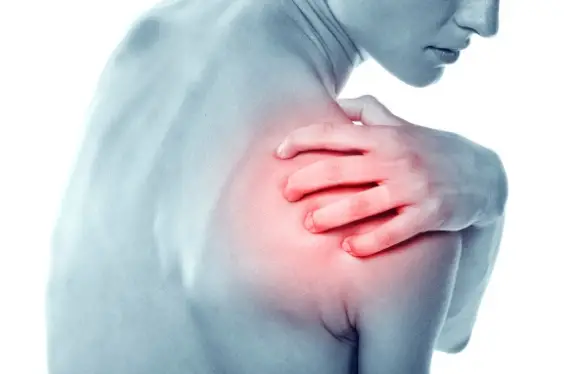Frozen Shoulder Symptom
Are you wondering about the question: what is a frozen shoulder symptom? If not then you can get the answers here. Another known name for frozen shoulder is known as adhesive capsulitis. In this condition, there is a restriction of motion which is caused by the shoulder joint. Frozen shoulder symptoms are not always associated with discernible cause or injury. But there are people who suffer from these symptoms after undergoing a traumatic injury.
Frozen shoulder is a painful condition of the shoulder called adhesive capsulitis. It limits the movements of your shoulder and in some severe cases, it can make you unable to move your shoulder. The shoulder capsule (the connective tissues in the shoulder joint) becomes inflamed and stiffened.
Contents
Who Is Affected By Frozen Shoulder Symptom?
The exact cause is unknown, but there are some people more likely to develop this condition. If you have diabetes, a previous shoulder injury or surgery, a condition where small lumps of thickened tissue form in the hands and fingers called Dupuytren’s contracture or other conditions like heart disease or stroke, rheumatoid arthritis, lung disease. Studies have shown that frozen shoulder can appear as a possible adverse effect of some forms of highly active retroviral therapy (drugs that treat the infections with HIV, but not only that). Most people after 40 years of age are affected and there is a slight predilection for women compared to men. Patients with diabetes have a longer recovery time and are prone to more complications.
Age and Gender
People within the age bracket of 40 and 60 years are most affected by this condition. Moreover, it is commonly seen double times in women rather than men.
Therefore, it can be said that age and gender play an important role in this disease. And so the answer for what is a frozen shoulder symptom can be seen in the above-mentioned age bracket.
Endocrine Disorders
Frozen shoulder can be developed by patients with diabetes as well. In addition, other endocrine abnormalities like thyroid problems also may result in this condition.
Surgery or Shoulder Trauma
If a person has sustained shoulder injury or had undergone a shoulder surgery then frozen shoulder joint may develop. If there is prolonged joint immobilization then the risk of frozen shoulder is at its peak.
Other Systemic Conditions
Various systemic conditions like Parkinson’s disease and heart disease are also associated with risk of frozen shoulder. These are some of the answers to what is a frozen shoulder symptom. The actual reason for frozen shoulder is not yet fathomed. The shoulder joint is basically a socket and ball joint. The arm bone at the top is the ball and shoulder blade is the socket.
A certain capsule of tissue surrounds the ball-and-socket joint and envelops it. This tissue for some reason becomes scarred and stiff. Usually, more motion is allowed by the shoulder joint compared to any other joints inside the body. And so when it is affected movements of the shoulder become painful with persistent stiffness. This makes it difficult to carry out the normal shoulder movements.
There are 3 stages of frozen shoulder and they advance slowly spread over a couple of months or even years. However, the symptoms may vary for different persons but the stages of what is a frozen shoulder symptom area mentioned in the following lines.

The Main Symptoms
Pain and stiffness are the major symptoms of this disease. Shoulder blade pain and the stiffness can make it difficult to move and carry out the full range of shoulder movements. Everyday tasks like bathing, dressing, driving or even sleeping properly are getting difficult to execute. A frozen shoulder usually has a gradual progression, over a longer period of time. It can start with aching and shoulder blade pain when reaching for things, with worsening at night and when you lie on the side affected. Then the shoulder becomes increasingly stiff, the shoulder pain remains the same but the movements become more restricted. The last stage is the stage where you regain some shoulder movement back and the pain will begin to fade, with periods of activation.
Symptoms With Common Stages
Stage one:
During the first stage, you will feel the shoulder aching and become stiff which results in a lot of pain. At night the pain gets worse as you lie down. This stage may last for 2 to 9 months.
Stage two:
Next, is called the adhesive stage. During this time your shoulder will become increasingly stiff. Your shoulder muscles might dissipate as it is not in use. This stage may continue from 4 to 12 months.
Stage three:
In this stage, you will slowly regain the shoulder movement. The pain will fade away although it may return at times. This is the reply to the question what is a frozen shoulder symptom and its recovery stages.
Frozen Shoulder Treatment
The treatment plan focuses on restoring the mobility of the joint, and also trying to reduce the pain. It can involve physical therapy and/or surgery. Also, it must try to reduce the muscular atrophy (loss of muscular tissue) on the affected side. The treatment plan often includes medications against pain and inflammation.
Painkillers and/or corticosteroid injections (anti-inflammatory drugs) might be used by your doctor in treating this disease. The physical therapy may include massage therapy and daily stretching, but any kind of physical activity is recommended because the more you don’t move your shoulder, the more stiff and painful it will get.
Physical therapy is also recommended in the prevention of frozen shoulder. The exercises and stretches must be performed several times daily. Also, applications of moist heat to the shoulder can help to loosen the joint and provide relief of pain because the blood vessels dilate in the presence of heat and allow a better blood flow to the area.
Surgery means that the doctor breaks up the adhesions under general anesthesia. Surgery may be indicated in cases that are severe and have been evolving for many years. The procedure is usually minimally invasive and is performed by arthroscopy. The recovery time is as well fast and also requires the patient to perform physical exercises to shorten that period.
- Featured image source: sports health


